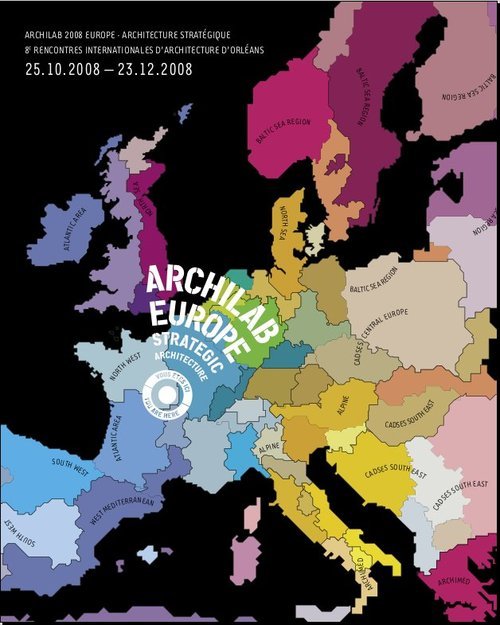Archilab Europe 2008
dal 24/10/2008 al 22/12/2008
Segnalato da
24/10/2008
Archilab Europe 2008
Frac - Fonds regional d'art contemporain du Centre, Orleans
Strategic architecture. The exhibition will focus on and discuss the relationship between political goals and the built and envisioned environment. The ideas behind such an analysis of urbanism and architecture are informed by current developments in Europe: cities and architecture in Europe are increasingly influenced by demographic change, the forces of the global market, and competition between the cities and regions. A unique panoramic view of current European trends in architectural creation and spatial planning.

8e RENCONTRES INTERNATIONALES D'ARCHITECTURE D'ORLEANS
Archilab Europe – Strategic Architecture aims to present the decisive and strategic role of architecture and planning interventions as a tool for the development of cities and regions, and show the links with funding structures within the European Community. The exhibition will highlight in particular how architecture and strategic plans of action may be linked up with one another. In doing so, the exhibition poses the question of whether, given this context, Europe may be viewed as a testing ground for new approaches to architecture or planning. Do these “strategic architectures” stimulate and promote innovative development and dynamics in the cities and regions?
Archilab 2008 shows the importance of the European Union in the context of urbanism and architecture today. The exhibition will focus on and
discuss the relationship between political goals and the built and envisioned environment. The ideas behind such an analysis of urbanism and
architecture are informed by current developments in Europe: cities and
architecture in Europe are increasingly influenced by demographic change,
the forces of the global market, and competition between the cities and
regions. While some regions are pushed to the “outer limits” of the economic and cultural centres, other regions make use of transnational cooperation projects or establish themselves as well-organised “islands” in
order to assert themselves on the market. Many regions in Europe are also
dealing with severe shrinkage issues. These topical processes of transformation invite a new analysis of architecture and urbanity in Europe.
In view of the heterogeneous situation in the cities and regions of Europe,
the European Community has been working now for over twenty years on
specific policies and urban development strategies. Work in recent years in
particular has pushed the economic, social, urban and spatial advancement of Europe’s cities and regions, within the broader political framework
set out by the Lisbon Agenda in 2000. The main goal of the Agenda is to
make Europe the most competitive and dynamic knowledge-based economic area in the world. The strategy is driven by the further development
and growth of centres for these knowledge-based industries, thus promoting new restructuring processes in Europe. The goal is a polycentric Europe
that transcends the so-called European Pentagon, which includes the
strongest economic regions and cities such as London, Hamburg, Munich,
Milan and Paris, and which promotes diverse development and encourages
the participation of the new member states from the East in particular.
To realise this strategy, the European Union has set up a number of funding programmes that usher in and support these processes. The
programme in particular initiates, supports and funds relevant strategic
projects. The programme gives Europe a new, unfamiliar layout: overlapping transnational regions that pursue the same developments and goals.
Moreover, the economic centres practice a policy of “Strengthening the
Strengths” and a “Policy of Solidarity”, which aim to prevent weaker regions from “drifting away” or “giving up”. The policy of creating a balance
between the cities and regions in Europe may be described as a push and
pull strategy.
Given this background, Archilab Europe – Strategic Architecture aims to
present the decisive and strategic role of architecture and planning interventions as a tool for the development of cities and regions, and show the
links with funding structures within the European Community. The exhibition will highlight in particular how architecture and strategic plans of action may be linked up with one another. In doing so, the exhibition poses
the question of whether, given this context, Europe may be viewed as a
testing ground for new approaches to architecture or planning. Do these
“strategic architectures” stimulate and promote innovative development
and dynamics in the cities and regions?
OMAR AKBAR
Commissaire de l’exposition
Curator of the exhibition
ArchiLab has been introduced and produced by the City of
Orléans, in partnership with the Centre Regional Council and
backing of the Ministry of Culture and Communication
(Heritage and Architecture Office, Centre Regional Current
Affairs Office), in collaboration with the FRAC Centre
(Centre Regional Contemporary Art Fund).
Press communication
HEYMANN, RENOULT Associées
29 rue Jean-Jacques Rousseau – 75001 Paris T. +33 (0)1 44617676 F. +33 (0)1 44617440 info@heymann-renoult.com
FRAC CENTRE - 12, rue de la Tour Neuve 45000 Orléans
COLLÉGIALE SAINT-PIERRE- LE-PUELLIER - Cloître Saint-Pierre-Le-Puellier - 45000 Orléans



